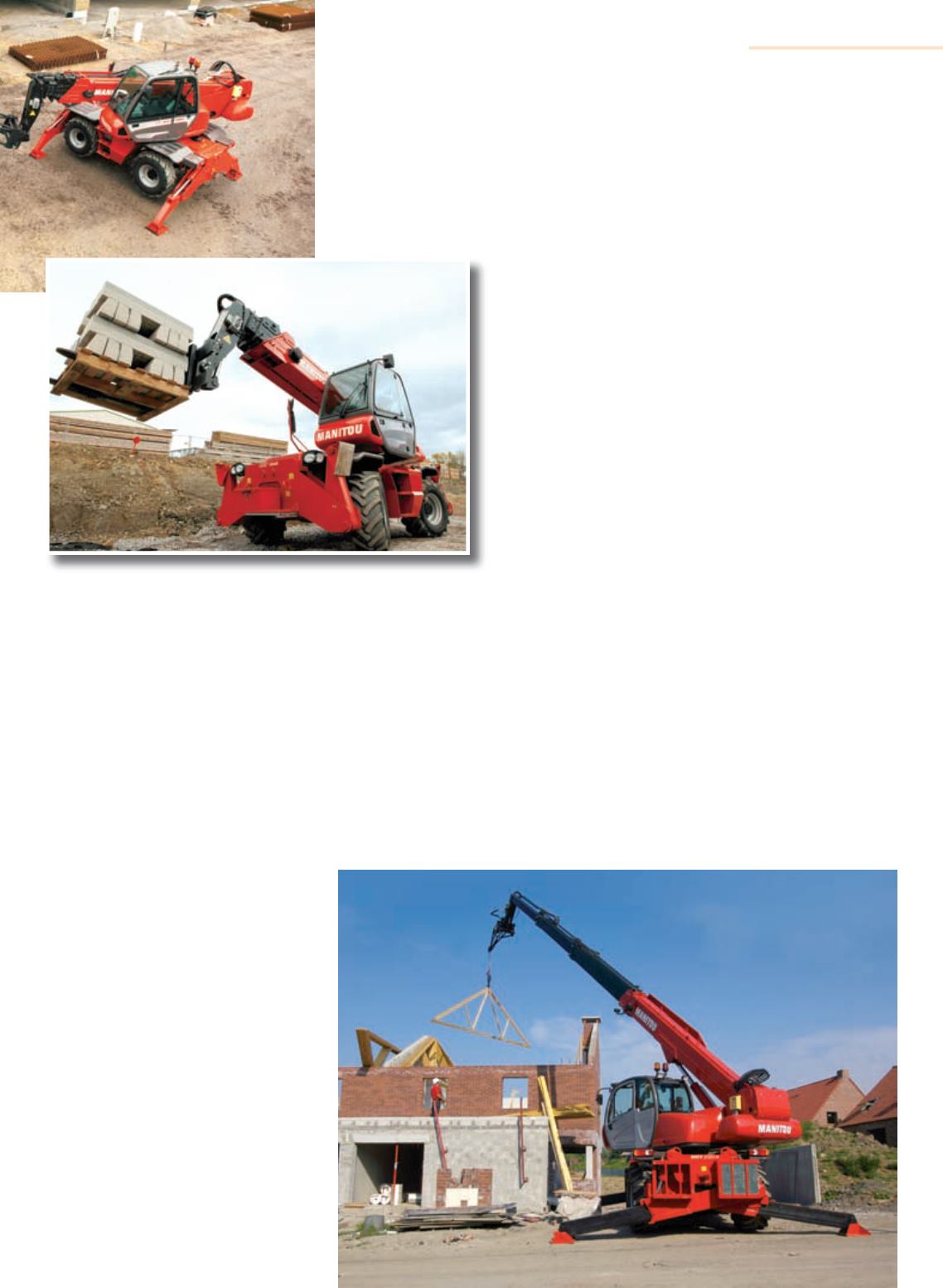
provide a solid foundation for lifting – no matter
what position the boom is placed.
“These machines work in close quarters,”
Gray says. “With a typical telehandler you
always have to drive straight up to where you’re
going to unload your load. Everything has to be
straight ahead of you. A lot of times if you’re in
an industrial application or where you’ll be in
alleys, you have the ability to rotate side to side.
You can pull straight down an alley and then
reach side to side to deliver your materials or
whatever work you plan to accomplish there.”
Then there’s the obvious rotation factor, which
according to Gray, is popular with masons and
industrial contractors.
“They can set this machine up close to the
building and then provide all the loads sitting
out from it. So, since it can slew around and
reach out, it can pick up loads and take them
up. Almost like a crane during building and how
it sits and places steal. This sits and places
materials and it doesn’t have to keep driving
back and forth.”
Education
With a rotating telehandler able to reach nearly
100 feet and lift loads similar to those a truck
crane might, it could be shocking as to why
the units aren’t more popular here. Then again,
changing a paradigm is never easy.
“At first, there is always skepticism,” Gray
says about customers-to-be. “In the U.S., jobs
are done the same way. You have to make
people see things differently and that’s not
always easy. You have to educate the customer;
show them the cost savings and what they can
accomplish with a rotating telehandler.”
While all those factors might point to good
sales, rotating telehandlers typically price-
out 30 to 50 percent more than a traditional
telehandler. It’s sticker shock. But many people
will vouch for how little time it can take to get a
ROI – some say 18 months is it.
“This is a lot less expensive than a crane,”
Gray says. “There
are less costs
associated with
operators –
compared to a ‘true’
crane operator –
plus the machine
is very versatile.
It has a number
of attachments
such as winches,
personnel baskets,
and more. That’s
where a lot of cost
savings come into
play.”
New units
In late 2013,
Manitou Americas debuted a number of updates
to its rotating MRT line.
The updated MRT Series includes the MRT
1840 Easy 360-degree, MRT 2150 Privilege Plus
and MRT 2540 Privilege Plus. The MRT Series is
designed to meet the needs of rental companies
and contractors in construction applications with
space constraints.
The MRT 1840 Easy 360 is powered by a 101
hp (74.5 kW) Perkins Interim Tier IV-certified
turbocharged engine and the MRT 2150
Privilege Plus and MRT 2540 Privilege Plus are
powered by 150 hp (110 kW) Mercedes-Benz
EPA Tier III turbocharged engines. The engine
automatically adapts itself to the needs of the
transmission system. This provides significant
Manitou made a number of updates and
changes to its rotating telehandler line,
including the MRT 1840 pictured here.
fuel consumption reductions by matching engine
output to the machine’s operation, Manitou said.
The two-speed hydrostatic transmission in all
models provides power and control for precise
placement of the machine. The MRT Series
models feature 4-wheel drive and oscillating
rear axles.
With a lift height of 80 feet and 8.5 inches
(24.6 m) on the MRT 2540 Privilege Plus,
operators can move materials to high buildings
and structures, elevate work platforms and
carry out service and maintenance work for the
mining, oil and gas industries. Lift capacities
are 11,000 pounds (5,000 kg) on the MRT 2150
Privilege Plus and 8,800 pounds (4,400 kg) on
the MRT 1840 Easy 360 and MRT 2540 Privilege
Plus models.
The new E-RECO – Automatic Attachment
Recognition – system comes standard on the
MRT Series. The system automatically senses
the attachment when correctly installed and
assigns the correct load chart and safe operation
zones. This allows the operator to know the lift
capacities of the attachments he/she is using
around the jobsite.
Front and rear stabilizers come standard on
the MRT Series. A telescopic scissor design on
the Privilege Plus models enables the legs to be
partially deployed when obstacles are present
or space is limited. When the stabilizers and
pads are retracted, they are integrated into the
machine’s body. There is no loss of ground
clearance or addition to machine width, Manitou
said. An adaptable calculator adjusts the load
chart and lifting zones based on the position of
the stabilizers.
For increased safety, an oscillating axle
lock-out system engages when the machine is
standing on its wheels and the upper structure
is rotated by more than 15 degrees. This allows
work to be completed with a larger area of
stability for the machine.
A spacious, ergonomic cab is equipped with
two electro-hydraulic joysticks that control
TELEHANDLERS
A Manitou MRT 2150 with a
jib attachment.
17
JANUARY-FEBRUARY 2014
ACCESS, LIFT & HANDLERS


